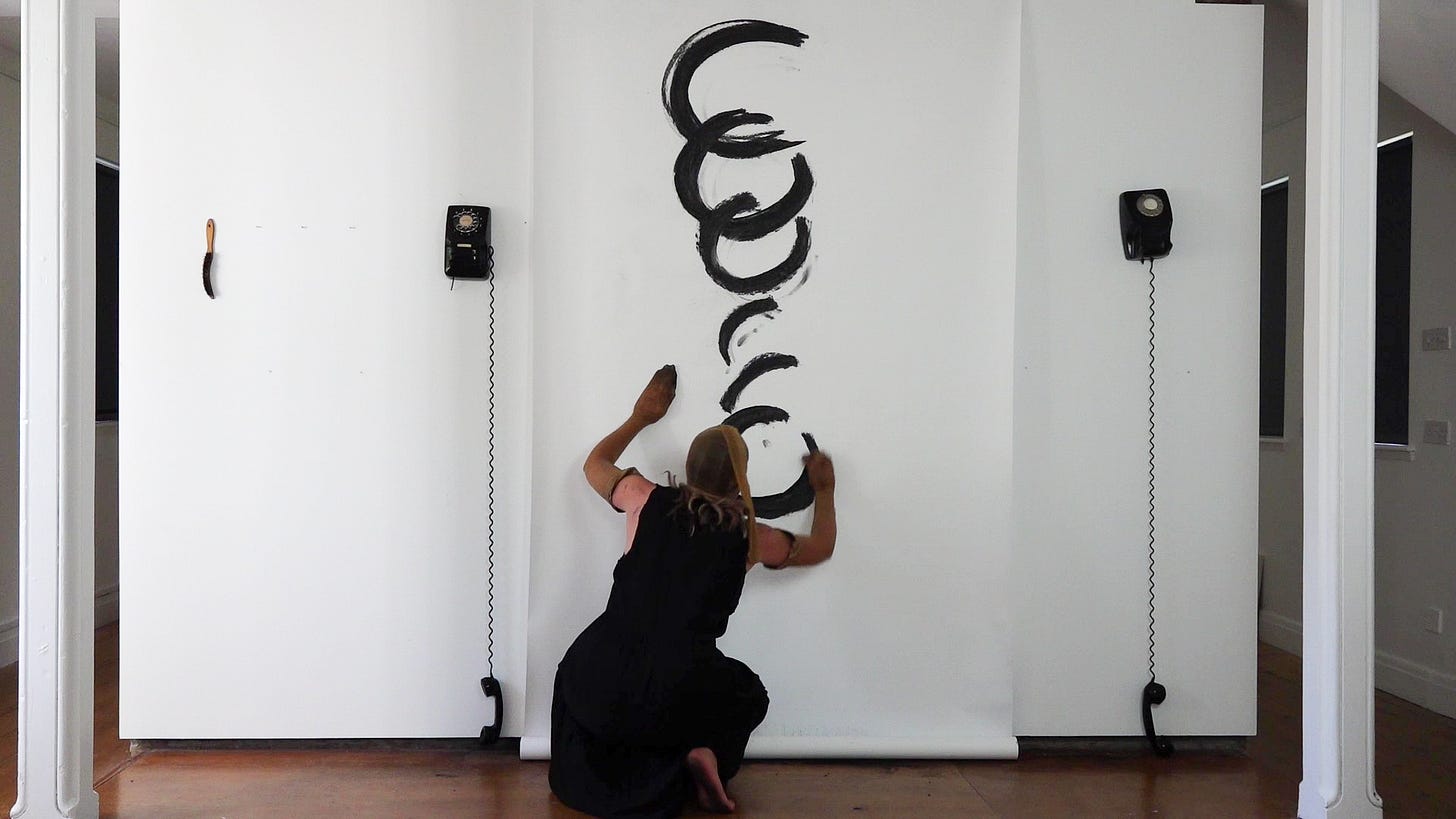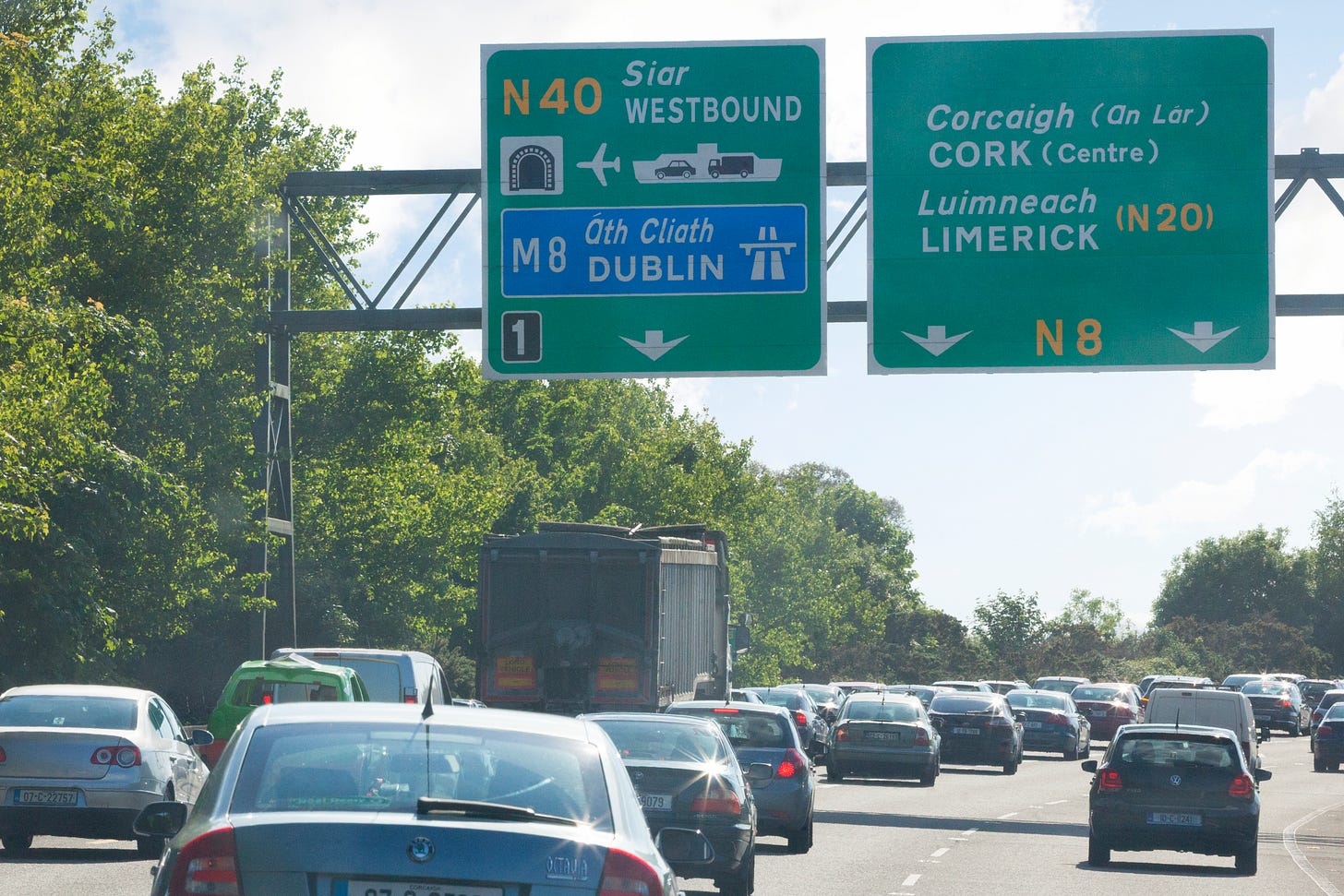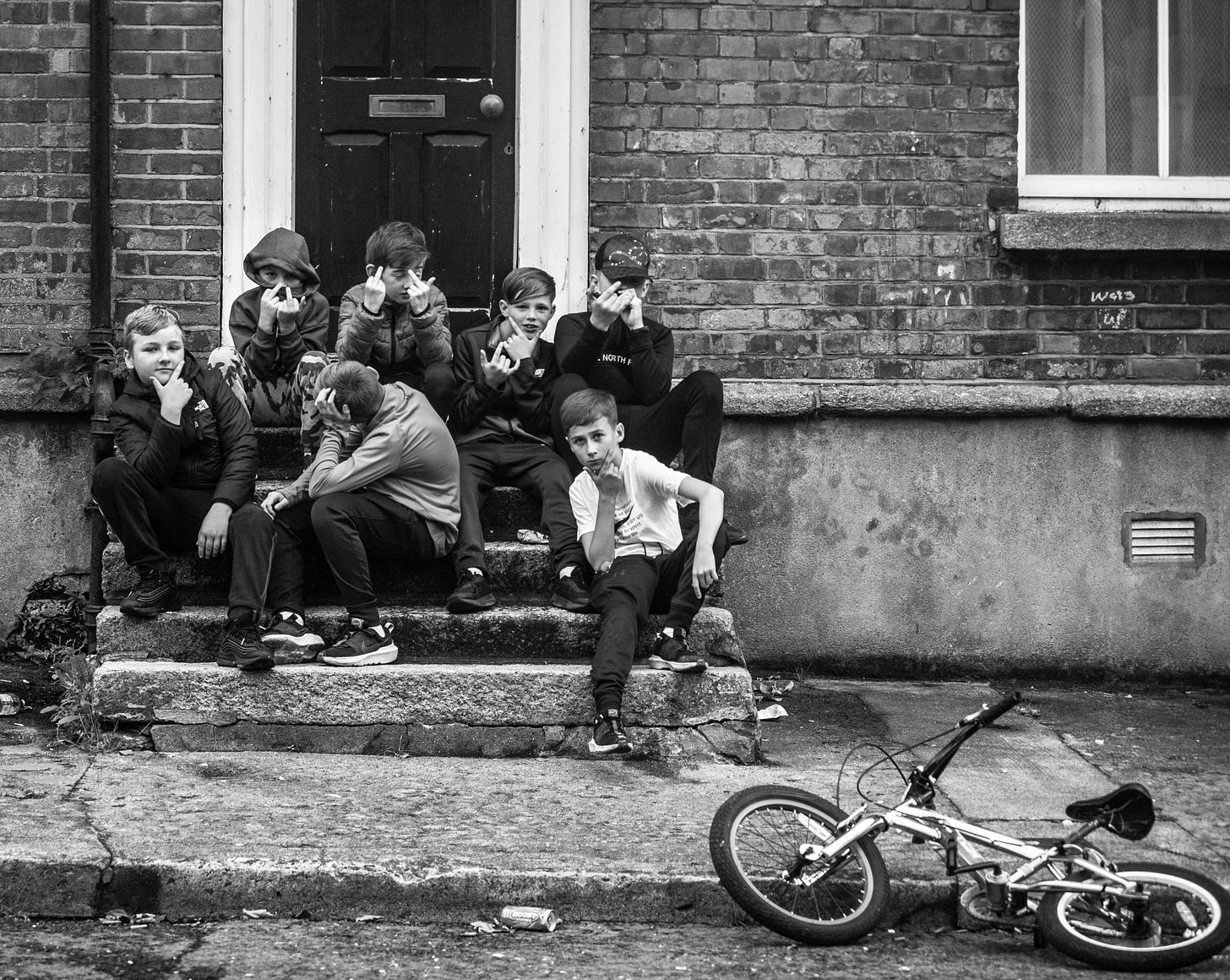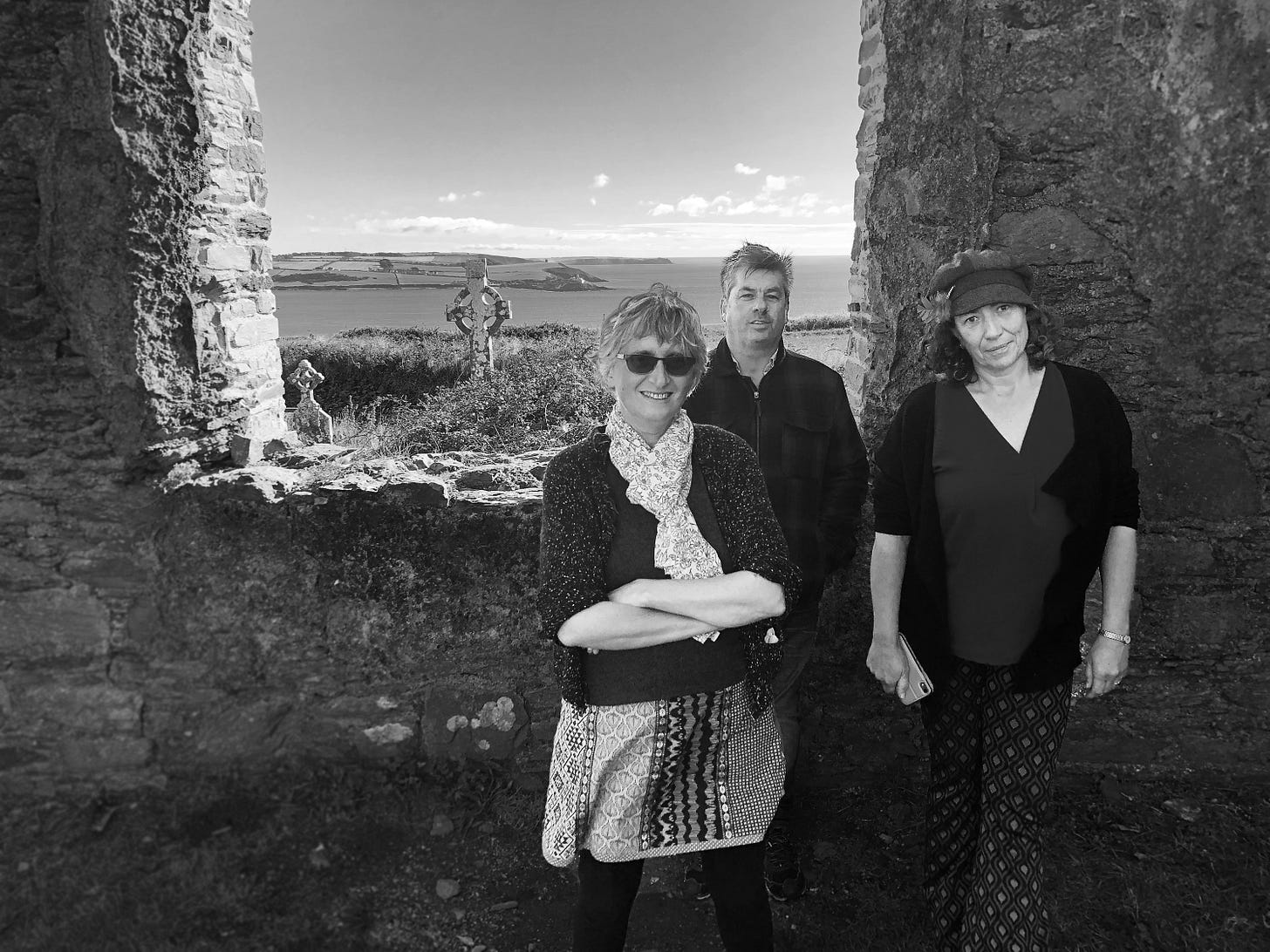The Friday View 07/10
How to make traffic disappear as well as our weekly round-up of news and a few recommendations for your culture calendar
Stuck
In April of this year researchers from the Organisation for Economic Co-operation and Development (OECD) held a series of workshops in Dublin looking at car and public transport use in Cork, Dublin, Sligo and Kildare. As part of those workshops invited guests from NGOs, universities, local and national government were given a task to imagine how streets in their areas would be used in 2050.
But here’s the kicker: they were told that “private car ownership had become culturally unpopular or even unacceptable.” With that in mind, the assembled groups had to discuss the following thought experiment:
Imagine a typical street or road in your area in 2050. What does the street look like? Who do you see and what are they doing?
Imagine a broader picture, a “helicopter view” of the area in 2050. Where are homes and destinations located? What connects them? What is there more or less of?
Think about who (e.g. children going to school, the elderly, delivery workers) could already be using each transport mode more often by 2025 and what would need to happen (e.g. easy to implement changes in infrastructure, increases in public transport services) to enable this.
It’s a worthy exercise, and I imagine it probably took a while for some people to get their head around the starting point, that “private car ownership had become culturally unpopular or even unacceptable.”
There was a reason for this, as the report’s authors outline: “Mental models or visions relative to car use can often prevent policy makers from imagining and implementing transformative policies, to move the country away from car dependency.”
Taking cars out of the equation gave people the freedom to think about how space is used, but also how transport happens. It’s unrelated, but reading this part of the report made me think about how Douglas Street was transformed for the Autumn Fest a few weeks back when cars were removed from the street for just one day.
The thought experiment is just one part of the OECD report entitled Redesigning Ireland’s Transport for Net Zero Towards Systems that Work for People and the Planet which was officially launched this week in Dublin.
It’s a wordy and worthwhile report and the top line is that Ireland has a car dependency problem, with three out of four adults opting to travel by car on a daily basis. What they found is that infrastructure spending here has, up until quite recently, centred around the car: we build more and better roads with cars in mind which in turn has driven up private car ownership. More cars results in more traffic and so we spend more to accommodate cars. The result, as you’ve likely noticed driving in the city or in many town centres, is near constant traffic jams. And journey times are taking way longer than they should.
Last year, I wrote a news piece about traffic in Douglas and David Teixeira-Lynch who placed a Telraam device which records traffic flow along a street in west Douglas, in Cork city where he lives. You can access the data he records here. I dropped David a line this week to ask him if he had noticed traffic spikes since the return to school in September. Traffic was up, as predicted, with more than 60,000 vehicles flowing through the village on a weekly basis.
What the OECD recommends is that if Ireland is going to halve emissions in the transport sector by 2030 we need to reimagine how roads are used, so that public transport becomes more efficient and more widely used. It would also help with increasing active travel (cycling, scooters, walking etc).
Last weekend, Virgin Media had a short report from Ballincollig highlighting some of the concerns of business owners there, including those of former Lord Mayor Colm Kelleher, about how BusConnects plans would hamper business in the area. The report subsequently drew criticism in that it was entirely one-sided. BusConnects is centred around what the OECD calls road space reallocation - especially by prioritising bus corridors.
There is evidence though that road space reallocation away from car use works. There’s even a term for it: “disappearing traffic.”
“Evidence on disappearing traffic has been documented for several years now. After examining over 70 case studies of road space reallocation in 11 different countries, Cairns, Atkins and Goodwin (2002) concluded that, given the right conditions, road space reallocation can result in significant reductions in traffic: on average, the case studies examined resulted in a 21.9% traffic reduction, while in half of the cases, at least a 10.6% drop in car traffic was found. The authors find that the claim that road space reallocation is associated with “traffic problems” is “unnecessarily alarmist.”
The OECD report runs for hundreds of pages and it drills down into many of the reasons why we are such a car dependent nation (our housing policies also play a major role) and how we can turn this around, and perhaps someday soon witness disappearing traffic, like we see once a year on Douglas Street.
-JJ
News in brief
Construction has started on 34 new houses in Bantry all of which will be social housing. They will be built by Kieran O’Sullivan Construction and consist of a mix of one, two, three and four-bedroom houses. Work is underway on the €9.5m turnkey social housing development with the first phase of 10 houses due to be complete next year according to Cork County Council. The county council plans to build 3,200 new social houses across the county between 2022 and 2026.
Cork City Council and the Women’s Caucus launched a ‘Period Dignity’ pilot this week. As part of that eight sanitary units, containing free sanitary pads and tampons, were installed at various locations across the city including in City Hall and most public libraries. Lord Mayor Deirdre Forde, speaking at the launch, said she was hopeful that the pilot would break the stigma associated with periods.
The plan to build an outlet centre similar to Kildare Village but in Carrigtwohill rolled back into the news cycle again with the announcement that the government has gone against the Office of the Planning Regulator, which had instructed Cork County Council not to allow Rioja Estates forge ahead with its plans to build the retail centre. Carrigtwohill is facing into a decade of huge construction projects as the population is set to increase to 10,000 by 2028. You can read our long read about the changes coming down the road at Carrigtwohill here.
Out + About
🎥Take a musical tour of Dublin’s North inner city, in Cork’s inner city. Yes, we know that to Tripe + Drisheen readers Cork is the centre of the known universe, but it’s worth a filmic visit to the place that likes to call itself the capital in the company of director Luke McManus for North Circular: this is veteran director McManus’ debut feature-length music documentary. Inspired by the experience of lockdown, he turned his camera on his own neighbourhood and created an ode to Dublin’s North inner city in the company of some familiar faces in the world of music. Perfect Sunday viewing, with a Q&A with McManus after the screening.
Time, date, place: 4pm, Sunday October 9, at The Gate Cinema. Tickets at box office.

🖼Drawing Connections, now on at the Lord Mayor’s Pavillion in Fitzgerald’s Park grew out of giving 10 MTU students access to the Crawford Art Gallery back in May as part of National Drawing Day. The resulting exhibition, staged by Sample-Studios, is an electic response to pieces from the Crawford collection but also to the Pavillion and Fitzgerald’s Park. The exhibition also offers a chance to see the work of emerging artists. More information here.
Time, date, place: 11am - 4pm, Wednesday to Saturday, October 6- November 3, The Lord Mayor’s Pavilion in Fitzgerald’s Park.
🎶Celebrate the full moon with a gig in magical Cork Harbour surroundings with Crosswinds who will perform in the ruins of St Matthew’s Church this Saturday. The chruch was built in 1778, but torn down a century later. The three-piece features Katrina Emtage, a classically trained flautist, multi-instrumentalist Ruti Lachs and singer-songwriter Billy Kennedy. It’s a stunning location for what promises to be a memorable perforamnce. Tickets and more information here.
Time, date, place: 7pm, Saturday, October 8, St Matthew’s Church, Templebreedy, Crosshaven
🖼Sunday tours. Every Sunday afternoon, the Crawford Art Gallery stages free tours of the gallery. There’s no booking required, you simply need to show up at 2pm, in the scuplture gallery, just inside the main door on the left. The tour lasts about 50-60 minutes and you’ll get the lowdown on current and permanent exhibitions as well as history about the only national gallery outside Dublin.
Time, date, place: 2pm, Crawford Art Gallery, Emmet Place
This week on T +D
Thursday was a busy news day for Ellie as she published two news stories. On Thursday morning she wrote about the plans for Cork Harbour which include stopping all shipping activities on the quaysides in Cork city “in the near future”. Today, (October 7) in Cobh, you’ll be able to see those plans for the harbour during the Public Consultation Day, 1pm-7pm at Sirius Arts Centre.
On Thursday evening, Ellie wrote about the plight of a 61-year-old Ukrainian woman who was ejected from Cork hotel and forced to sleep rough for two nights. You can read that piece here.
To get high-quality journalism about Cork in your inbox every week, join our free email list now.
That’s it for this week’s Friday View. Be sure to stop by tomorrow for our weekly Arts+Culture newsletter/podcast. Any tips, news or events you’d like to share with Tripe+Drisheen, you can contact either of us at jj.odonoghue@gmail.com or emailellieobyrne@gmail.com. We are always happy to speak to people off the record in the first instance, and we will treat your information with confidence and sensitivity. Get in touch.






